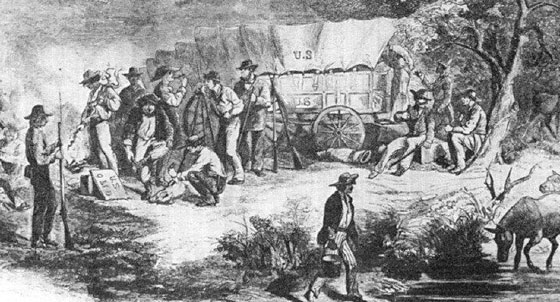Palo Alto Battlefield
The prairie of Palo Alto and the nearby field Resaca de la Palma were scenes of a battle from the U.S-Mexican War, but the sites also had significance to the Civil War. Dozens of young officers who experienced some of their first combat in the clashes with Mexican troops on May 8th and 9th 1846, moved up to positions of leadership in the Civil War. Ulysses S. Grant, George Gordon Meade, Don Carlos Buell, and 21 others became Generals in the Union army. James Longstreet, John Pemberton and 12 more of their peers became Generals in the Confederate ranks. Edmund Kirby Smith who was a lieutenant at Palo Alto, commanded the Trans-Mississippi Department of the Confederacy, which included Texas and the Rio Grande Valley.
Although the battlefields did not witness fighting during the Civil War, the Palo Alto prairie was a camping spot for Union forces when they arrived to seize control of the Rio Grande in the autumn of 1863. Groups like the 37th Illinois Volunteer Infantry bivouacked on the site on their way to the occupation of nearby Brownsville. The sites also had great symbolic value for these Union soldiers who (though a generation later) well remembered battles during the war with Mexico. Major Augustus Pettibone of the 20th Wisconsin volunteers captured the thoughts of many of his peers when he wrote home to explain the invasion of the Rio Grande delta: “We have come,” he said, “as armed citizens of the Union to occupy and possess our own, to recover the soil for which our elder brothers fought and bled in the war with Mexico, and to once more unfurl the ensign of the republic along this southwest border, made historic ground for all time by the battles of Palo Alto and Resaca de la Palma.”
Listen
El prado de Palo Alto y la cercana Resaca de la Palma constituyeron el escenario de una de las batallas de la Guerra Méxicoestadounidense, también denominada «Guerra de la Intervención». Docenas de jóvenes oficiales que experimentaron sus primeros lances de batalla durante las refriegas con las tropas mexicanas entre el 8 y el 9 de mayo de 1864 fueron ascendidos a puestos de mando durante la posterior Guerra de Secesión. Ulysses S. Grant, George Gordon Meade, Don Carlos Buell, y 21 más acabaron ocupando el cargo de general en el ejército unionista. James Longstreet, John Pemberton y 12 más de sus compañeros acabaron con el mismo rango en las filas confederadas. Edmund Kirby Smith, quien fuera teniente en Palo Alto, fue el jefe de la región militar del Departamento del Oeste del Mississippi de la Confederación, que incluía Texas y El Valle del Río Grande. Aunque estos campos de batalla no albergaron enfrentamientos durante la Guerra de Secesión, el prado de Palo Alto constituyó un asentamiento de acampada para las tropas unionistas cuando llegaron para tomar el control del Río Grade en el otoño de 1863. Agrupaciones como la 37 de Intantería de Voluntarios de Illinois acamparon allí a cielo abierto durante su avance para ocupar la cercana localidad de Brownsville. Ambos lugares también acarreaban un gran valor simbólico para los soldados unionistas que, una generación más tarde, recordaban bien las batallas durante la guerra con México. El mayor Augustus Pettibone, de la 20 de Infantería de Voluntarios de Wisconsin, capturó los pensamientos de muchos de sus compañeros cuando escribió a los suyos explicando la invasión del delta del Río Grande: «Hemos venido como ciudadanos armados de la Unión para ocupar y tomar posesión de lo nuestro, para recuperar la tierra por la que lucharon y vertieron su sangre nuestros hermanos mayores durante la guerra con México y para, una vez más, desplegar la enseña de la República a lo largo de la frontera del suroeste, convertida para siempre en territorio histórico por las batallas de Palo Alto y de la Resaca de la Palma.
Escucha
Details
Location: Brownsville - FM 511 and FM 1847
Access: 8 am-5 pm
Contact: Doug Murphy

